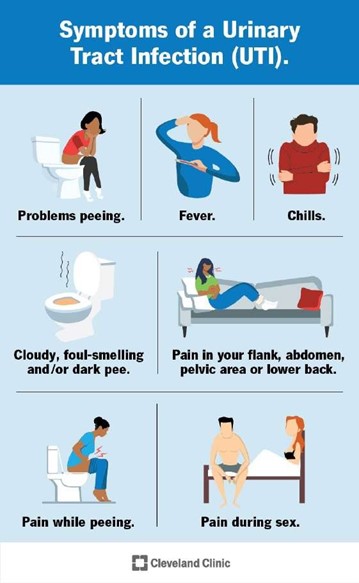The client has been diagnosed with urinary tract infection (UTI). Which of the following is a common symptom of UTI.
Nausea.
Diarrhea.
Dysuria.
Constipation.
The Correct Answer is C
Dysuria, which means pain or a burning sensation when peeing, is a common symptom of urinary tract infection (UTI).

UTIs are caused by bacteria entering the urinary tract through the urethra and spreading to the bladder or kidneys.
Choice A is wrong because nausea is not a specific symptom of UTI, although it may occur if the infection spreads to the kidneys.
Choice B is wrong because diarrhea is not a symptom of UTI, but rather a condition that affects the digestive system.
Choice D is wrong because constipation is also not a symptom of UTI, but a problem with bowel movements.
Normal ranges for urine tests vary depending on the type of test and the laboratory that performs it.
However, some general ranges are:
Specific gravity: 1.005 to 1.030
pH: 4.6 to 8.0
Protein: less than 150 mg/dL Glucose: less than 130 mg/dL Ketones: none
Blood: none Nitrites: none
Leukocyte esterase: none Bacteria: none or few
White blood cells: less than 5 per high-power field Red blood cells: less than 3 per high-power field Epithelial cells: few
Nursing Test Bank
Naxlex Comprehensive Predictor Exams
Related Questions
Correct Answer is B
Explanation

This is because hyponatremia is a condition where sodium levels in your blood are lower than normal, usually due to too much water in your body that dilutes the sodium. A hypertonic saline solution is a fluid that has a higher concentration of sodium than blood, and it can help restore the normal sodium balance by drawing water out of the cells.
Choice A is wrong because restricting fluid intake may not be enough to correct severe hyponatremia, and it may worsen the symptoms of dehydration.
Choice C is wrong because encouraging increased fluid intake will further lower the sodium levels and increase the risk of complications such as brain swelling.
Choice D is wrong because administering a loop diuretic will cause more sodium and water loss from the kidneys, which can worsen hyponatremia and dehydration.
Normal ranges for blood sodium levels are between 135 and 145 milliequivalents per liter (mEq/L).
Hyponatremia is defined as a blood sodium level below 135 mEq/L1.
Correct Answer is ["A","C","D"]
Explanation
Furosemide is a loop diuretic that causes the kidneys to excrete more water and salt, which can lead to dehydration and electrolyte imbalance.

Electrolyte imbalance can cause muscle cramps, numbness and tingling, weakness and fatigue, and other symptoms.
Therefore, the client should monitor for these signs and report them to the doctor if they occur.
Choice B is wrong because dry mouth is not a sign of electrolyte imbalance, but rather a sign of dehydration.
Dehydration can also cause thirst, decreased urination, drowsiness, and confusion.
Choice E is wrong because tachycardia is not a sign of electrolyte imbalance, but rather a sign of hypovolemia (low blood volume) or hypotension (low blood pressure).
Furosemide can lower blood pressure by reducing fluid volume in the body.
Therefore, the client should also monitor their blood pressure and pulse regularly while taking furosemide.
Whether you are a student looking to ace your exams or a practicing nurse seeking to enhance your expertise , our nursing education contents will empower you with the confidence and competence to make a difference in the lives of patients and become a respected leader in the healthcare field.
Visit Naxlex, invest in your future and unlock endless possibilities with our unparalleled nursing education contents today
Report Wrong Answer on the Current Question
Do you disagree with the answer? If yes, what is your expected answer? Explain.
Kindly be descriptive with the issue you are facing.
